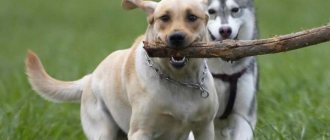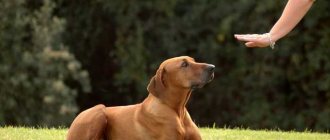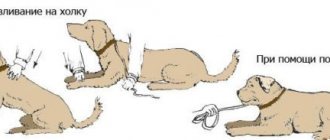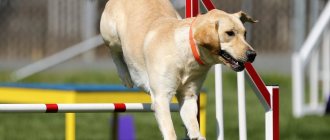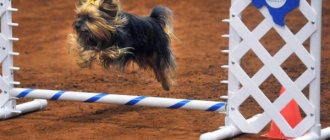The “Crawl” command is usually used for military dogs. It is given when an animal needs to crawl under cover with a canine soldier. However, we will look at a simplified version of this exercise and tell you how to teach your dog to crawl on command for fun.
“Crawl” is a rather strenuous exercise that requires significant effort from the animal. Don't force your dog to crawl for too long, otherwise he will lose the desire to exercise. If your pet has problems with joints, then it is better to refuse training altogether.
Algorithm for learning the “Crawl” command.
Teaching your pet to crawl on command will take some effort. If training takes place at home, you need to remove all sharp objects from the floor that could injure your pet.
It is worth teaching the command outside only in the warm season. The ground should be dry and warm, the training area should be chosen with grass or sand. Training on the ground with sharp rocks and bumps is unacceptable.
Proper training should be carried out in a place where there are no other cats, cats, or other animals. There is no need to rush while studying.
A little theory
What does the "Crawl" command mean? When ordered, the animal must lie down and crawl over a certain area. If we are talking about competitions, then the length of the segment to be overcome is at least 10 meters wide, about two meters.
When developing a skill, several unconditioned stimuli are used at once:
- taste;
- forced: pressure on the withers and a jerk with the leash.
To conduct classes, choose a clean, level and dry area without any traumatic objects: broken glass, stones, branches, etc. Ideally, at first it is better to train on a rubber surface or in a specially equipped gym. Later, when the skill is mastered, the working conditions become more complicated and bring them as close to reality as possible.
Before starting training, the animal must undergo a general training course, or, in extreme cases, be able to flawlessly carry out the “Stand” and “Lie down” commands. In addition, the dog must be able to work in any climatic conditions and not be afraid of gunshots and other sharp sounds.
When selecting pets for border service, preference is given to the following animals:
- hardy and physically developed;
- with good coat;
- with a pronounced food reaction;
- indifferent to strangers;
- balanced mobile type.
To get used to the command you need to do the following:
- Give the command “Lie Down”.
- Position yourself so that your pet is on the left.
- Take the leash in your right hand.
- With your left, press the pet’s withers a little down and forward.
- Command “Crawl.”
- Pull the leash forward.
If the dog moves correctly, it can be praised and treated. Some pets have to be held down by force as they try to jump up. Successful execution of a command is considered to be the situation when the dog crawls 50 cm for the first time. “Crawl” training implies a gradual increase in distance, as well as execution of the command without a leash and the owner nearby.
When following a command does the dog fall on its side? Here the dog handler may advise you to squeeze the back of the dog’s body between your legs and, as it were, hang over it.
For stubborn people who don’t want to crawl, a dog psychologist will recommend using the method with your favorite treat. The dog is simply not allowed to get up, but they are not pulled by the leash, but beckoned with their favorite treat.
A more experienced dog can demonstrate the execution of the command. Dogs learn from each other very quickly. Any gesture for executing a command without giving a voice can be set.
Teaching a dog to crawl long distances
Now gradually increase the distance the dog must cover. To make her task easier and prevent her from jumping up, practice the following scheme.
Command your dog to “Down,” and squat in front of him with your legs spread wide apart. Place your hand holding the treat behind your back between your legs and make sure your dog sees the treat in your hand. Then say the command “Crawl.” When the dog crawls under you, reward it and praise it. Repeat the exercise several times.
Reward your dog when it crawls under you
This position (under you) may be uncomfortable for the dog. If you see that your pet is in doubt, then build a special structure for training. Place stacks of books on each side and place one or more boards on top.
Gradually increase the distance between you and the lying dog - squat not directly in front of it, but half a meter, then a meter and then increasing. If at any stage the dog gets up, then you were probably in a hurry and moved too far away. Go back to the previous distance and practice it again.
In parallel with increasing the distance, it is necessary to get rid of squats. In this case, also act gradually - first practice the option when you stand with your legs slightly bent, then straight, and then completely teach her to cope without your help.
“Crawl”: working on mistakes.
Any correction of a dog’s behavior cannot be carried out using rude and cruel methods. It is unacceptable to hurt your pet during training. You shouldn't pull the leash with all your might either.
There is no need to scold incomprehensible pets. To train a dog, the owner can use the pet's physiology. You can always build a tunnel from old boxes or tires where the dog will have to crawl.
“Crawl” is a difficult but necessary command that is useful for your pet in many ways. If the dog is healthy, then it is capable of crawling quite long distances. It may take a month of training to consolidate a useful skill.
Skill complication
When the animal learns to crawl next to the trainer, you can begin the second part of the training, namely, teaching it to move without a person.
- They give the command “Lie down.”
- A tasty morsel is placed at a distance.
- The trainer approaches the pet, presses it to the ground by the withers so that the student does not rise up without permission, says “Crawl” and slightly guides the animal forward.
- When the dog crawls to the treat, he is patted encouragingly, praised and given the treat.
Important: the dog should not pick up the food on its own, it should be given by a person!
After developing the initial skill, they move on to working in more difficult conditions:
- increase the length of the obstacle;
- training is carried out outdoors, in bad weather and on uneven ground;
- the animal is taught to crawl from any position.
The command is considered completed when the dog obeys unquestioningly the first time and crawls at least ten meters on its own and with the trainer.
Tricks for enthusiasts
It’s easy to train a domestic dog to fetch slippers, play thimbles or hide-and-seek, walk another pet on a leash, run next to a bicycle, sit in the “gentleman” position, and dance on its hind legs.
The cup trick is quite easy for an animal to perform. Three identical plastic cups are placed in front of the dog. There is a treat under one, then the cups are moved from place to place in front of the dog’s eyes. Then they offer the pet to get a treat. Each attempt to turn the glass over is accompanied by exclamations of praise. The dog's reward will be the treat he finds. The exercise is repeated several times.
Cup game
What should you pay attention to?
Some dogs may not crawl for a treat, but may fall onto their side, so try to keep your hand level. If you are faced with such a situation, then correct your pet, tell him: “No,” put him in the right position, and say: “Yes.” Then the dog will understand what he needs to do to be praised. Also, you can reward your pet with a treat so that he remembers the starting position faster.
You can train your pet only in a calm tone. You should not show aggression, raise your voice, or show your dissatisfaction with gestures, as dogs sense this and may simply be afraid. Therefore, be patient and make an effort, and soon you will see how your pet happily carries out the desired command.
Raising your pet dog is a fascinating process, but it also requires patience and perseverance on your part.
Teaching the command “crawl!” It should be done when you have already taught your dog the basic commands.
Crawling is not a typical movement for a dog, so this command is not easy for everyone to learn. Before you start training, properly practice the “lie down!” command, otherwise you will not achieve success. As soon as the dog confidently executes the command “lie down!”, i.e. not only lies down on command, but also continues to remain in this position until the command is canceled, we begin to teach it the command “crawl!”
Choose a quiet place for training. Either you are training your dog in a group setting at a dog park where everyone is doing the training, or you need to be careful not to be distracted.
1st method of training. Place the dog opposite you and command him to “lie down!”, while simultaneously indicating the direction of action with your hand (i.e., make a sharp downward movement with your outstretched arm, palm facing the floor/ground). After the dog lies down, bring the treat to its nose, hold your hand close to the ground and command “crawl!” When the dog tries to get up, put him down again and repeat the command. Treats can be given when your dog tries to approach you without getting up on his paws. Increase the distance your dog moves until he crawls at least a meter.
2nd method of training. Stand straight, the dog should be on your left side in the “sit” position. Say the command “down!” loudly and clearly. at the same time pointing to it with a hand movement, as in step 3. After the dog lies down, take the treat, hold it near the dog’s muzzle, not allowing it to grab it, and gradually move it away with the simultaneous command “crawl!” With your other hand, hold the dog's back, preventing it from rising to its paws. Gradually increase the distance your dog moves.
Don't forget to praise your pet when he succeeds in following your commands.
After you have trained the dog to crawl some distances without holding the body with your hand, you can begin to further develop the execution of the command. Dog parks have structures that resemble low awnings, they are designed to allow the dog to crawl under this canopy. For the first attempts, you will need an assistant who will hold the dog on one side of the tent, and on the other you will command it to “crawl!” When the animal has mastered this lesson, begin training the helper. Send the dog forward, combining it with the command “crawl!” towards the canopy. Ideal result: when the dog, on command, quickly moves towards the canopy, crawls under it and returns to you, sitting on the left side at your foot.
Dog training at home - age and characteristics
The primary, basic training course can be carried out at home. This step is not very wise if you plan to show the dog at shows or participate in sports competitions. When planning a “dog career”, it is better to immediately contact professional dog trainers, who will teach your pet commands taking into account all the subtleties. When training a dog, it is important to understand that it is easier to teach it correctly right away than to retrain it.
Important! If you have got a puppy who will become a member of your family and companion, but does not claim titles, you can handle the entire training process on your own.
Preparing a puppy for training
The bulk of training occurs between 4 and 10 months of age. Before 4 months of age, it is important to carry out preparations: establish interpersonal contact with the puppy and “lay” the foundation of education. In a global sense, dog training can be divided into three important segments:
- Training is teaching your dog manners, obedience, and the ability to hear you.
- Socialization is training a dog to coexist normally with the outside world.
- Training is teaching a dog certain commands.
These three segments are interconnected and cannot exist separately:
- A perfectly trained dog will not obey you if it is ill-mannered.
- A well-mannered and trained dog will not obey you if it is influenced by irritating factors (low level of socialization).
- A dog may not know commands, but will listen to you if it is trained and socialized.
It is important to understand that raising, socializing and training a dog is done not only for the convenience of the owner. A four-legged animal will be under depressing stress if it is forced to constantly make independent decisions and doubt their correctness. Dogs are naturally driven, dependent on the owner and his emotions.
Training a teenage puppy outdoors
Outdoor training can begin after the puppy has received basic vaccinations. Until vaccination is completed and an immune response is developed, the puppy can be taken outside, but not to public walking areas. When walking outside, it is not recommended to let the puppy off the leash until the commands “Fu” and “Come” are fully mastered.
Note! It is recommended to conduct the first outdoor training in a closed area so that you can catch up with the dog if it gets scared and runs away. As an additional security measure, it is better to hang an address capsule or tag on your pet’s collar.
Statistically, teenage puppies between 4 and 10 months of age learn new skills best. Service dogs, who are naturally able to make their own decisions, take longer to train and are not always willing to do so. The intensity and success of training also depends on the dog’s temperament. The more active the four-legged animal, the more intense the training should be.
Features of training an adult dog
There is an opinion that it is useless to train an adult dog. This opinion is fundamentally wrong, since four-legged animals are capable of learning at any age, even in old age. The peculiarities of training an adult dog are that it is more difficult to find motivation for it.
Puppies respond well to food stimuli and willingly follow commands for treats. With an adult dog, this approach most often does not work.
Depending on the dog's temperament, toys or the owner's emotions are used as rewards during training. Food motivators should not be excluded, even if the dog reacts poorly to them in the initial stages of training. An older dog may need to be trained longer. Most likely, you will have to put more effort into practicing commands, since the older the dog is, the worse it reacts to monotonous practice of commands.
Overcoming obstacles
Training is also learning to overcome obstacles, be it a ladder, a barrier or a boom. First, teach your pet not to be afraid of projectiles: do not try to drag him by force, it is better to walk along the boom with him, stroking and encouraging the dog. Team "Barrier!" They begin to practice from low bars that the dog is able to step over. Walk through such an obstacle several times, gradually its height can be increased. If the dog refuses to jump right away, sit him in front of the barrier, and stand on the other side and call your pet. Be sure to help your dog overcome high obstacles so that the animal does not experience fear or pain when jumping. Gradually, you can accustom the dog to gestures and other obstacles.
A well-trained dog will become a true friend and reliable protector!
What will you need to teach your dog commands?
When a four-legged pet appears in the house, it is not only joy and happiness, but also a lot of trouble. Every owner wants his pet to be smart and obedient, but not everyone can achieve this. Inexperienced dog owners complain that their dog is supposedly so stupid that it is incapable of even performing the simplest tasks. In fact, these animals are very smart and intelligent, you just need to find a special approach to them. Basically, training begins at 4-6 months. The simplest option is to send your pet to special OKD courses, but you can start raising it yourself. In this article we will tell you how to teach your dog commands .
Before you start training, be patient and prepare a soft collar, leash, and rewarding treats for your pet - crackers, pieces of meat or dry dog food. The place for training also needs to be chosen wisely - it should be quiet and secluded. You should not train your dog near a highway or playground - noise and screams will distract your pet. Reinforcement should be given after each correctly executed command. Say tasks clearly and loudly, supporting your words with gestures, but do not resort to shouting. The dog must learn to respond to your calm, confident voice.
Teaching the command “Give me your paw!”
This command is also a basic one and is practiced after the puppy has learned to sit and lie down according to the trainer’s word. The easiest way is again to use the taste-enhancing method. To do this, take a piece of treat, lift it higher, but so as not to cause pain or discomfort to the pet, and give the command “give your paw.” Then hold your paw in this position for a few seconds, release and give the tasty piece, caress your pet.
Teaching the command “Near!”
This command is to counteract external stimuli. The dog should be at the trainer's left leg while moving. First, keep the animal on a leash: it is worth remembering that dogs do not have innate discipline, and if the animal feels freedom, it will certainly take advantage of it. Command "Near!" should become a kind of brake, capable of drowning out innate instincts. Coercion works best here - pulling the leash. As soon as the dog begins to move to the side without a command, a painful tension on the leash occurs, but as soon as it returns to the leg, the unpleasant sensations stop. As soon as the animal has returned to its place, say affectionately “Near!” and lightly pet the dog.
If the dog is distracted from the exercise, give the command again and jerk the leash. A well-trained dog should learn to walk side by side without a leash. You can change the pace of movement, distance, terrain. You should not pull on the leash often, otherwise the dog will constantly pull you forward in order to subconsciously avoid pain.
If something went wrong
Some animals categorically refuse to crawl. There are several clever tricks for this case:
- The dog is held by the withers and forced to move by a forced pulling motion on the leash.
- The animal is squeezed between the legs, preventing it from turning over on its back, and with its hands it is forced to crawl forward with the words of command. As soon as the pet understands what is required of it and begins to move, the order is immediately pronounced again and encouraged.
Errors:
- excessive use of force, especially in the first lessons,
- being forced to cover too long a distance,
- poor conditions for crawling: presence of sharp objects on the obstacle course, wet surface, etc.

